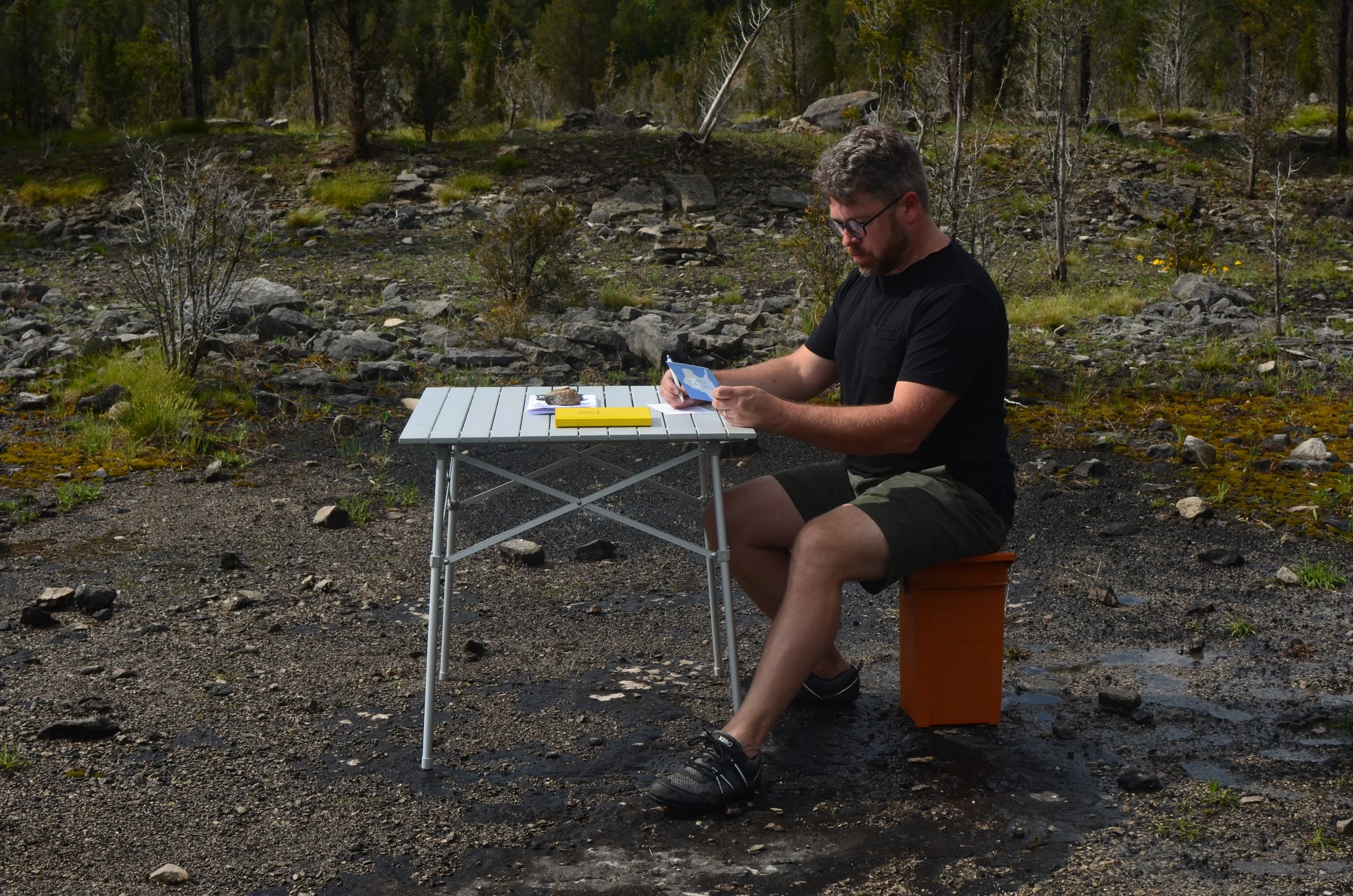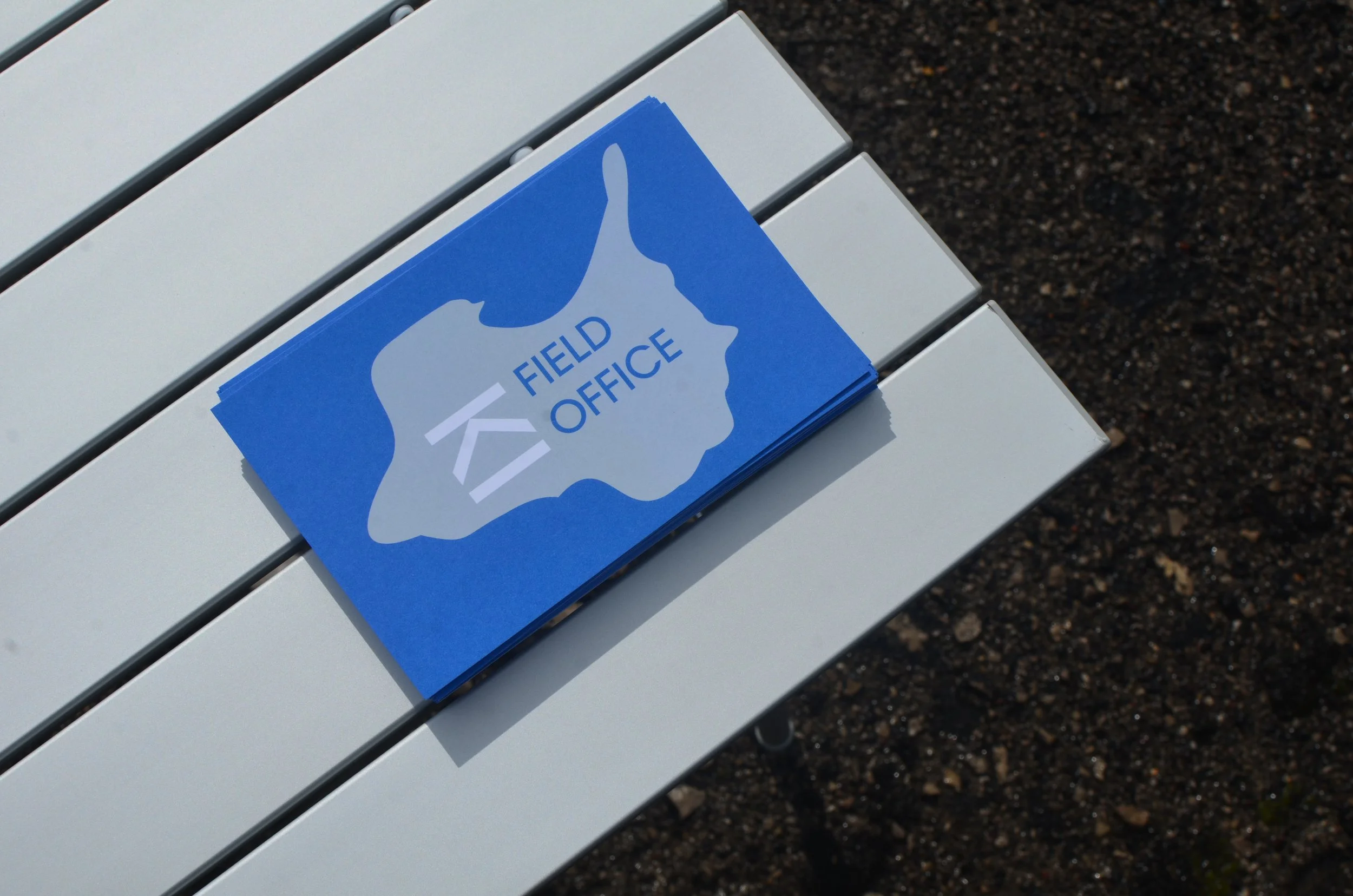15. LEARNING FROM POSTCARDS
As I’ve embarked on planning an expedition to Baffin Island to see the Laurentide Ice Sheet, and I’ve begun my local research on how that ice sheet shaped Kelleys Island and the Great Lakes Region, I’ve drawn on a historic communication tool for expeditions in the past: hand-written mail. I’ve looked at letters, but I’ve also looked at postcards, QSL cards, and cachet envelopes. In this post I’ll write a little about how some of these have influenced my communication strategy, and why. (nb: later posts that relate to postal and philatelic interests will be categorized as “mail & stamps”)
I started sending out a postcard to my archive at the Nevada Museum of Art, and a duplicate copy to my personal studio archive each time that I set foot on Kelleys Island. It functions as a timecard, but it’s also a kind of handwritten personalized artist-book that logs the activities I undertake while aiming to communicate something about the geologic history that I’m investigating. It takes about four hours for me to write the entire set of postcards, get them stamped, and hand them to the post office clerk to be hand-canceled with the Kelleys Island post office label. Here’s a photo of me writing postcards onsite in the quarry:
Here’s an image of the postcards I’m sending out to my subscribers:
QSL CARDS & DX-PEDITIONS
I began to be interested in sending postcards logging my activities when I came across a special type of postcard called a QSL card. QSL cards come from amateur radio operators who send them to each other to confirm radio contact with a particular operator. These types of cards are collected as a record of radio contact and show the extent of one amateur radio operator’s communications across the planet (and even to the International Space Station). The name QSL comes from a type of radio code used to communicate longer messages with shortened Q-codes, and QSL is the spoken code phrase meaning “I confirm receipt of your transmission.” So a QSL card is just a written acknowledgement of having a successful QSL between two radio stations. They’re fascinating and radio operators have personalized cards made for their stations that they send out after contact.
There is a special category of QSL cards that is even more relevant to my work, and that’s a “DX-pedition card.” This Kingman Reef Dxpedition card from 1980 is the card that drew me into this world of postcard reporting:
obverse
Wikipedia defines a DX-pedition like this:
“A DX-pedition is an expedition to what is considered an exotic place by amateur radio operators and DX listeners, perhaps because of its remoteness, access restrictions or simply because there are very few radio amateurs active from that place.”
And so a DX-pedition card is one that outlines the details of the expedition, the particulars of the activities and reports the connection of a radio transmission at a time and place with the operator’s station code and the radio frequency used to transmit.
Here’s an image of the reverse side of the QSL card:
reverse
The reverse side of the card has several types of information: a printed itinerary of the major events that transpired during the DX-pedition, a narrative, and a form-field with spaces to indicate particular dynamic details of the transmission. This QSL card is not a mailable postcard, because the layout doesn’t meet international postal requirements for postcards like the need for an address area and indica for postage. It’s also smaller than a mailable postcard. This type of card would have been sent in an envelope to the recipients of the transmission.
When a DX-pedition is being planned, it’s announced on a bulletin board and listserv to radio operators who will then book a time slot with the transmitting DX station. This way there is a record of who will be tuning in and how to contact them to send them the QSL card. In the case of this Kingman Reef DX-pedition, 5,500 QSO’s were made from Kingman Reef on January 11, 1980 by a team of operators. This card was filled out by radio operator AA8Z for the transmission they made at 16:43 GMT.
POLAR EXPEDITION CACHET ENVELOPES & POSTAGE
Another type of printed expedition mail pieces that I studied in my design phase was the cachet envelope. It’s a type of envelope with a printed image on the left side of the front of the envelope, and includes a destination address area and a stamp at minimum. Some cards include other details on the fronts like stamped information that takes place during the expedition that could not have been known ahead of time to be printed on the envelope.
Here is an example from my collection of polar expedition envelopes:
Often expeditions and permanent research stations will have a supply of these pre-stamped envelopes, and collectors can request the research station to send an envelope, although there are significant guidelines around sending “covers” or stamped envelopes. For instance, the National Science Foundation’s United States Antarctic Program Participant Guide offers the following information on how to handle requests for mail:
“Philatelists (stamp collectors) are interested in receiving mail from Antarctica, and the NSF has a procedure to support philately at a level not to interfere with the science mission…While in Antarctica, you may receive unsolicited philatelic mail from collectors. The Foundation discourages this unauthorized philatelic activity, and you will be entirely within your rights in declining to respond to such unsolicited requests. Please discard the material in the appropriate recycling container…Philatelists may obtain a maximum of two covers (self-addressed stamped envelopes) a year by writing to the postal clerks (addresses below) at the three year-round U.S. Antarctic stations. No more than two covers per person per station per year. Covers will be processed for personal (that is, noncommercial) use of individuals only…” (p60, NSF: 2016)
But historically, these types of correspondence provided important public relations communications for expeditions and gave the public a sense of connection to the expeditions. This is one of the reasons I’m borrowing from this postal tradition in my projects on Kelleys Island with FIELD OFFICE and the Baffin Island expedition. Here are a couple of other covers and cachet envelops from multi-national expeditions that I brought into my collection during this research phase:
I was drawn to the left printed side of the envelope (above) that featured a map of Antarctica and the color blocks in crisp printing. I also liked the way the six flags were represented on the cover.
This cover (above) has interesting inked stamp seals on the cover that I may think about adding to my correspondence field desk set, and there is this interesting dot pattern included on the bottom left corner of the envelope which was designed for producing a uniform six-digit number. The reverse of the envelope (below) shows a key to how each number should be notated in the dot pattern, and I included it below because it provides a way to customize an envelope in ways that I haven’t seen on other envelope covers.
I found a lot of covers from Antarctica, but my expedition is headed north, so I started looking for a cover that was more representational of the area I will be in when I take a granite glacial erratic 2,243 miles north to reach the remnant ice cap of the glacier that first moved my stone. I found this cover from Baffin Island and knew I had to have it in my collection. I like the line drawing of the island on this cover (below):
FIELD OFFICE POSTCARDS & STAMPS
The postcards I am sending from FIELD OFFICE to the people who subscribed were formatted with QSL cards in mind. Here is the backside of the first version of the postcard before I had to redesign them:
When I received this card in my studio mailbox, I was surprised to see that the cancel was made by machine instead of by hand, and that it was not made on Kelleys Island. On my next trip to the island I talked with the postal clerk who was helpful in understanding some of the issues with the mail routing. We decided I would hand them to her during post office hours instead of placing them in the curbside mailbox, which means I now have to ensure I write my cards before the post office closes for the weekend, and so since I mail them before my trip is over, the cards don’t include details of my activities completed on the weekend. But they’re hand canceled which is what I wanted so that the archive shows the timecard was sent from Kelleys Island.
I’ve gone through two designs now for this postcard, the first design was completely scrapped after a month-long attempt at correspondence with an artist who had previously obtained rights for some of the language I unwittingly used on the card. I redesigned the card, had them reprinted, and began sending them out to subscribers in May. The redesign gave me a chance to adjust where I placed the form fields on the card which were obstructed by some of the machine cancel on the first set of cards. Here is what it looks like in the current iteration:
obverse
reverse
Here is what the newly designed card looks like when filled out:
I have not yet designed a cachet cover/envelope, but I intend to produce one both for FIELD OFFICE and the Baffin Island expedition.
There is so much to write about that is related to stamps, mail, and print communications, but I’ll save that for another day. Thanks for reading through to the end, I know it was a long post.
To be continued…












